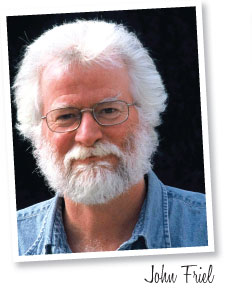6/1/2021
Speaking of Grasses
John Friel

It’s happened again: I was invited to give a presentation on ornamental grasses to an invisible audience, i.e., a Zoom conference. This one was a Master Gardeners group in North Carolina.
The talk itself was a reboot of one presented to a gardening club back in March, also in NC, which was an overhauled/updated PowerPoint show originally given in Illinois—in person, if you can remember when that was a thing—about two years ago.
When you’re used to looking your audience in the eye, this web-based remote stuff feels very strange at first. But it’s amazing, and a little troubling, how readily one adapts. For people younger than I, a larger percentage of the population all the time, this is far from a paradigm shift. It’s not entirely coincidental that Gen Z is also known as Zoomers. But quarantines and travel bans have made us all play catch-up. Digital reality is no longer an oxymoron even for Boomers.
COVID-19 didn’t beget Zoom; the company was founded in 2011. But the virus turned it viral, from corporate tool to household word, at warp speed, and it’s here to stay. Cyberspace will remain a valuable, viable venue for events formerly held f2f.
Zoom hasn’t changed one unfortunate fact of public speaking: If you do it long enough, everything that can go wrong eventually will. Internet connections fail, computers freeze, software picks inconvenient times to update, yada yada. My lecture circuit presence dates to the days of 35mm slides, so you can add dead mics, jammed carousels, tripped-over extension cords and burned-out projector bulbs to the Murphy’s Law checklist.
Revamping these talks has driven home how important, and how increasingly accepted, North American native plants have become in the global marketplace. Native grasses redefined as ornamentals are a little late to that party, but they’re catching up faster than a Boomer with a new laptop.
We’re not likely to see a steep decline in the popularity of Asian, Eurasian or African genera (Calamagrostis, Miscanthus, Hakonechloa, Cortaderia, Pennisetum, et al). But grasses have long since migrated from edge-y avant-garde gardens into the mainstream. And here come the natives: Panicum, Schizachyrium, Bouteloua, Chasmanthium, even Andropogon. With each refresh, natives have migrated into more of my slides, reflecting their real-life increases.
Just as remote learning hasn’t changed Murphy’s Law, the ever-growing importance and popularity of natives hasn’t repealed or weakened the Right Plant, Right Place rule. If there were an 11th Commandment just for horticulturists, it would be RP, RP.
Giving native plants, whatever your definition of native, a greater presence in our gardens and larger landscapes is a fine thing to do for myriad reasons, for the environment and the industry. But anyone who tells you that natives are automatically better, less problematic and especially “zero maintenance” is not your friend. Nativity alone is no assurance of suitability for a given place, no guarantee that an indigenous plant will perform better there than one that migrated here from another continent.
All good things have to come to an end. After giving various versions of this particular presentation three times, it’s time to scrap it for parts and create something new. There’s another talk coming up in the fall in the Midwest; this one will be (knock wood) in person. That calls for a fresh start in more ways than one.
One final Zoom note: Their IPO debuted in March 2019. Anybody got a time machine I can borrow, just long enough to buy some stock? I promise I’ll bring it back disinfected and with a full tank. Heck, I’ll even wax it. GP
John Friel is marketing manager for Emerald Coast Growers and a freelance writer.